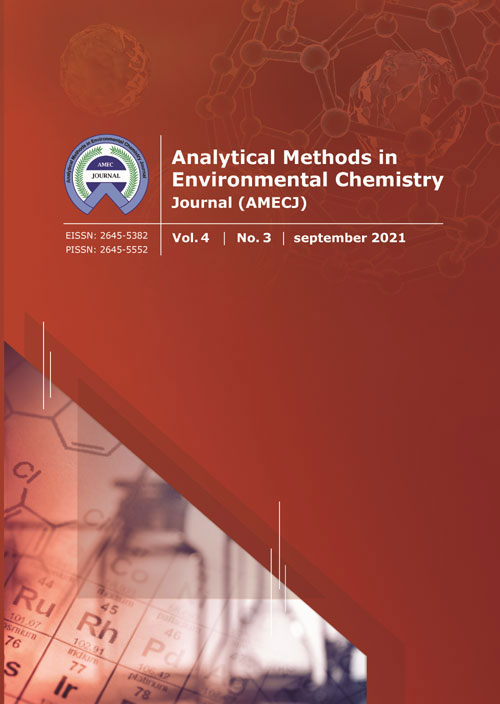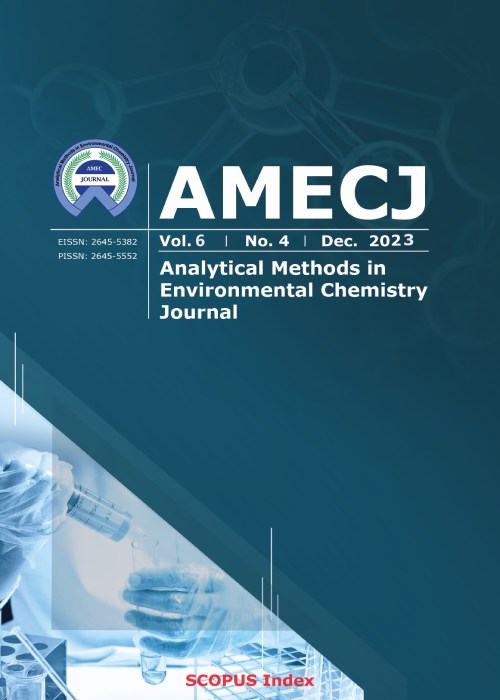فهرست مطالب

Analytical Methods in Environmental Chemistry Journal
Volume:4 Issue: 4, Dec 2021
- تاریخ انتشار: 1400/10/19
- تعداد عناوین: 7
-
Pages 5-19
In this study, the amount of photocatalytic degradation of perchloroethylene in the gas phase was investigated by a fixed bed continuous-flow tubular photoreactor. The photoreactor consists of a cylindrical glass tube, was filled with glass beads coated with nanoparticles of TiO 2 , and TiO 2 doped carbon (TiO 2 -C). These nanoparticles were synthesized by the sol-gel method and deposited on glass beads using the sol-gel dip technique. X-ray diffraction (XRD), scanning electron microscopy (SEM), Fourier transforms infrared spectroscopy (FT-IR), and diffuse reflectance spectroscopy (DRS) were used for the characterization of synthesized materials. The effect of different parameters such as relative humidity, residence time, PCE concentration on the photocatalytic degradation process was investigated by ultraviolet irradiation to achieve the highest possible degradation efficiency. The PCE degradation and byproduct species were monitored and identified with a gas chromatography- mass spectrometer device (GC-MS). Under the optimum experimental conditions, the photocatalytic activities of TiO 2 , TiO 2 -C were investigated and compared together. The results showed that photocatalytic activity of TiO 2 for degradation of PCE was extremely increased when doped with carbon. For TiO 2 -C catalyst, under UV irradiation (3000 ppm initial PCE concentration, 30% humidity and 1 min residence time) approximately 96% of the initial PCE was degraded. Also, the catalyst showed high stability over 48 h without a decrease in catalytically efficiency. All results show that TiO 2 -C is a good candidate for application PCE degradation.
Keywords: TiO2 nanoparticles, Photocatalyst, Chlorinated volatile organic compounds, Pollutant degradation, Sol-gel, Gas chromatography-mass spectrometer -
Pages 20-35
Lithium regulates the concentration of nitric oxide in the human body and a high dose of nitric oxide causes multiple sclerosis (MS). Also, the amount of manganese in the cerebrospinal fluid alters the metabolic reactions associated with MS. In this study, the mixture of the ammonium pyrrolidine dithiocarbonate (APDC), the hydrophobic ionic liquid [HMIM][PF6] and acetone coated on the surface of graphene oxide nanoparticles (GONPs) and used for separation Li and Mn in human samples by ultrasound assisted-dispersive-ionic liquid-micro-solid phase extraction technique (USA-DIL-μ-SPE) at pH 6.0. After extraction and back-extraction, the amount of lithium and manganese in the blood, serum and urine samples was determined by the flame and the graphite furnace atomic absorption spectroscopy (F-AAS, GF-AAS), respectively. By optimizing parameters, the LOD, Linear ranges (LR) and preconcentration factor (PF) for Li and Mn ions were obtained (0.03 mg L -1 , 0.25 μg L -1 ), (0.1-0.4 mg L -1 , 0.08-1.5 μg L -1 ) and 10, respectively (%RSD<5). The capacity adsorption of APDC/IL/GONPs and GONPs was achieved (148.5 mg g -1 , 122.3 mg g -1 ) and (41.3 mg g -1 , 33.7 mg g -1 ) for Li and Mn ions in a static system, respectively. This method was successfully validated by spiking samples and certified reference materials (CRM).
Keywords: Lithium, Manganese, Human samples, Multiple sclerosis patients, Nano graphene oxide, Ultrasound assisted-dispersive-micro-solid phase extraction -
Pages 36-48
Benzene has a carcinogenic effect on the human body and adsorption from the air is the best way to control it. By this research, benzene vapor was removed from the air based on a tantalum metal-organic framework (Ta-MOF) by gas flow solid-phase interaction (GF-SPI). Benzene adsorption with Ta-MOF was studied in the static and dynamic systems at room temperature. The benzene concentration was analyzed by gas chromatography equipped with an FID detector (GC-FID). The factors affecting benzene removal efficiency like initial concentration of benzene, amount of adsorbent, exposure time, flow rate, and temperature were studied and optimized. The results showed us, the adsorption capacities range of Ta-MOF for benzene in the static and dynamic system were obtained between 90-160 mg g -1 and 65-135 mg g -1 , respectively. Also, the high removal efficiency was achieved by more than 95% at 45°C, 67.5 mg L -1 benzene concentration, 0.5 g of Ta-MOF, and the flow rate of 250 mL min -1 for a dynamic system. By dynamic system, the benzene is generated in the chamber, stored in a bag, and then moved on the surface of Ta-MOF. The GF-SPI method was validated by GC-MS and spiking real samples.
Keywords: Adsorption, Gas flow solid-phase interaction, Tantalum metal-organic framework, Gas chromatography -
Pages 49-63
The life-threatening nature of high nitrate concentrations in various water resources motivated the present study to investigate the nitrate adsorption by ZSM-5 nanozeolite and the feasibility of increasing nitrate removal efficiency using iron-doped ZSM-5 (ZSM-5/Fe) nanoadsorbent. The optimal adsorption conditions were determined first by modeling the central composite design (CCD) using Design Expert.7 software based on four influential factors of contact time, pH, adsorbent dosage and initial nitrate concentration. Then, the isotherms of nitrate adsorption under optimized conditions were investigated using the degree of fit of experimental data with Langmuir and Freundlich models for mathematical modelling of the nitrate adsorption process. Based on the test design results, the highest nitrate removal efficiency (%93.1) was determined with UV- Vis spectrophotometry at the contact time of 150 min, pH value of 3, the adsorbent dosage of 4 g L -1 and initial concentration of 40 mg L -1 . Analysis of adsorption isotherms also confirmed the greater fit of the experimental data with the Freundlich equation, so that the correction factor of the Freundlich equation was greater than the Langmuir equation, due to the heterogeneous distribution of active sites for adsorption on the ZSM-5/Fe nanosorbent surface. Therefore, it can be concluded that ZSM-5/Fe is a high efficiency nanosorbent for nitrate removal from water resources .
Keywords: Adsorption, ZSM-5, Fe nanozeolite, Freundlich, Langmuir, UV-Vis Spectrophotometry -
Pages 64-77
In this study, vanadium recovers from an alkaline solution based on the precipitation process and response surface methodology. A white salt ammonium metavanadate was obtained using the ammonium chloride precipitation method. Ammonium chloride was added directly to the alkaline liquor solution and the pH was adjusted approximately between 5 and 7 to form the white salt. The parameters affecting the recovery of vanadium, including the ammonium chloride concentration, the pH and the vanadium concentration in the caustic solution, were examined. The precipitation time had no significant influence on the vanadium recovery. The concentration of vanadium in the caustic solution and the concentration of ammonium chloride used for the precipitation were inversely related. It was found that a high recovery (over 90%) can be achieved with ammonium chloride and vanadium with concentrations over 4% (w/v) or 1000 mg L -1 (in the lye solution). It has also been observed that working in the pH range of 5 to 7 results in over 90% recovery. The influence of the parameters mentioned on the recovery of impurities was examined and the optimal values determined. Ultimately, the maximum vanadium recovery (97.29%) was achieved at the optimal point obtained from the reaction surface methodology.
Keywords: Vanadium, Recovery, Ammonium chloride precipitation, Alkaline leach solution -
Pages 78-91
In this study, the manganese ions were extracted in the blood of rats based on desferrioxamine (DFO), deferasirox (DFX) and deferiprone (DFP) as chelators (ligands) by ionic liquid-liquid phase extraction method (ILLEM) before being determined by F-AAS. Also, the toxic effects of manganese on blood serum and hematology parameters such as: RBC, WBC, HGB, PLT and HCT were investigated. Male Wistar rats were randomly divided into control and toxic groups. Manganese chloride was administrated orally in low and high doses. Orally (deferasirox and deferiprone) or intraperitoneally (desferrioxamine) for 2 weeks. Results showed that exposure to manganese significantly increased both counts of hematology parameters and concentration of this metal ion in serum compared to the control group. By procedure, manganese was chelated with ligands in the blood of rats and then the hydrophobic ionic liquid (IL, [HMIM][PF6]) was added to blood samples. After shaking and centrifuging, the upper liquid phase was separated by an auto-sampler and manganese loaded in a mixture of IL/ligand was settled down in the bottom of the conical tube. The manganese ions were back-extracted from IL phase and the remained acid solution was determined with F-AAS. The linear range, LOD and enrichment factor for 10 mL of blood rats were obtained 25- 180 μg L -1 , 6.5 μg L -1 and 19.92, respectively. By chelation therapy extra manganese ions were removed from human serum and the normal hematology parameters were achieved.
Keywords: Chelators, Red blood cells, Toxicity, Ionic liquid-liquid extraction, Flame atomic absorption spectrometry -
Pages 92-106
In this research, meta-(4-bromobenzyloxy) benzaldehyde thiosemicarbazone (MBBOTSC) as a novel ligand was synthesized from the reaction between meta-(4-bromobenzyloxy) benzaldehyde and thiosemicarbazide under basic condition in water and ethanol as solvents. Ligand has the ability to chelate ions and therefore, it was used to form a complex and extract ions. So, the cadmium ions in water and wastewater samples were separated based on MBBOTSC by ultrasound assisted-dispersive-ionic liquid-liquid microextractionmethod (USA-D-ILLME) before determination by AT-F-AAS.The MBBOTSC ligand was added to the mixture of the ionic liquid/acetone(IL/AC, [OMIM][PF 6 ]) and then injected by syringe to 50 mL of water samples at pH 6-7.The sample was put into the ultrasonic accessory for 5 minutes, after complexation (Ligand-Cd; RS...Cd....RS), the water sample was centrifuged for 3 min for phase separation.Due to complexation and back-extraction of Cd in liquid phase, the amount of Cd ions in the water samples was determined by AT-F-AAS after dilution eluent (0.5 M, HNO 3 ) with DW up to 1 mL.In optimized conditions, the Linear ranges and LOD for 50 mL of water samples were obtained 1-36 μ g L -1 and 0.3 μ g L -1 , respectively (Mean RSD= 1.26%). The validation results were successfully achieved by spiking real samples and using electrothermal atomic absorption spectrometry (ET-AAS)
Keywords: Cadmium, Meta-(4-bromobenzyloxy) benzaldehyde thiosemicarbazone, Ligand, Synthesis, Metal extraction, Ultrasound assisted-dispersive-ionic liquid-liquid microextraction


